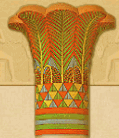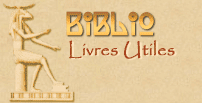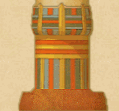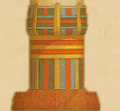 |
|
 |
||||||||||||||||





|

Voici quelques livres qui pourront vous être utiles... Bien entendu, pas de charlatanerie ici ! Les liens renvoient vers le site d'Amazon.fr, où vous pourrez avoir un aperçu plus complet des ouvrages proposés. Bonne lecture ! Les ouvrages magiques proprement dit, quasiment inexistants en français, sont ici. Navigation  La vie d'un égyptologue, même de nos jours, est souvent placée sous le signe de l'aventure. Bien sûr, il faut passer de longues heures dans les bibliothèques penché sur les papyrus, attentif aux textes des temples et des stèles. Mais toute cette érudition, si indispensable soit-elle, ne remplace pas un contact vivant avec ce splendide pays. Les statues guérisseuses, le " bon il ", les lois de l'amour magique, la protection de l'enfant..., voici quelques aspects parmi tant d'autres d'une magie partout présente dans l'Égypte ancienne et dont la connaissance permettait aux sages d'atteindre l'âge de cent dix ans. Christian Jacq a rencontré à Louxor l'une des plus célèbres familles de magiciens qui pratiquent toujours la chasse aux scorpions et aux serpents... Textes hiéroglyphiques et tradition orale révèlent la même vérité : il est possible au magicien, en harmonie avec les puissances créatrices, d'agir sur le monde. La magie ne fait-elle pas partie des " arts du Roi " pour nous convier à être, nous aussi, médiateur entre le ciel et la terre ? La vie d'un égyptologue, même de nos jours, est souvent placée sous le signe de l'aventure. Bien sûr, il faut passer de longues heures dans les bibliothèques penché sur les papyrus, attentif aux textes des temples et des stèles. Mais toute cette érudition, si indispensable soit-elle, ne remplace pas un contact vivant avec ce splendide pays. Les statues guérisseuses, le " bon il ", les lois de l'amour magique, la protection de l'enfant..., voici quelques aspects parmi tant d'autres d'une magie partout présente dans l'Égypte ancienne et dont la connaissance permettait aux sages d'atteindre l'âge de cent dix ans. Christian Jacq a rencontré à Louxor l'une des plus célèbres familles de magiciens qui pratiquent toujours la chasse aux scorpions et aux serpents... Textes hiéroglyphiques et tradition orale révèlent la même vérité : il est possible au magicien, en harmonie avec les puissances créatrices, d'agir sur le monde. La magie ne fait-elle pas partie des " arts du Roi " pour nous convier à être, nous aussi, médiateur entre le ciel et la terre ?  The author shows how she, her coven, and her friends, have come to know the deities of ancient Egypt, and how these Gods and Goddesses have enriched their lives. Included are meditations and techniques to help the readers bring those deities into their own lives. The author shows how she, her coven, and her friends, have come to know the deities of ancient Egypt, and how these Gods and Goddesses have enriched their lives. Included are meditations and techniques to help the readers bring those deities into their own lives.Also included are songs for the deities, rituals, information on hieroglyphs, two new forms of divination, names, incenses, oils, information and recipes for an ancient Egyptian feast, sources for statuary and other items, and even the best sites to visit on the World Wide Web. Instructions on the creation of a wand, nemyss, kilt, and sistrum are included. This book does not pretend to recreate the religion of Ancient Egypt, but rather to bring knowledge and worship of its deities into modern Pagan practice. Readers will have the tools to continue learning and developing their own methods of honoring the Gods and Goddesses of Tamera, the Beloved Land of the ancient Egyptians. Pour un coven Wiccan dont les pratiques font appel au panthéon Egyptien... En anglais...  The Goddess is alive. She always has been. But during the last two millennia, at least here in the West, She has been obscured. Occulted, but not erased, Her life-enhancing worship did not die. It was secreted within the inner teachings of esoteric societies, trivialized as folk custom, or enveloped within a mass of religious practices that officially denied Her Divinity while continuing to build cathedrals in Her name. For even though the Christian Fathers had long warned against making Mary into a Goddess, She functioned as Goddess for Her many adoring worshippers. And this is precisely the point. The Goddess is alive. She always has been. But during the last two millennia, at least here in the West, She has been obscured. Occulted, but not erased, Her life-enhancing worship did not die. It was secreted within the inner teachings of esoteric societies, trivialized as folk custom, or enveloped within a mass of religious practices that officially denied Her Divinity while continuing to build cathedrals in Her name. For even though the Christian Fathers had long warned against making Mary into a Goddess, She functioned as Goddess for Her many adoring worshippers. And this is precisely the point.She is. Official sanction has nothing to do with Her reality. Diminishing Her rituals into folk custom has nothing to do with Her power. Denying Her existence has nothing to do with our human need of a relationship with Her. Our humanity calls out for our Divine Mother, Sister, Grandmother, and Wife. We need the Creatrix, the Warrior Woman, the Wise Queen, the Lover and the Beloved, and the Divine Feminine Mystery. We need the entire range of aspects that the wholeness of Goddess provides us. God, too, needs Her; for without Her, He is incomplete. Throughout the history of the worship of Feminine Deity, She has been known by many names. Modern Goddess worshippers have understood, with Dion Fortune, that "all the Goddesses are one Goddess." This is expressed in a common hymn in the Goddess community that sings the names of many Goddesses as a way to invoke the one Goddess: Isis, Astarte, Diana, Hekate, Demeter, Kali, Inanna!  The various aspects of Isis are examined in a very readable fashion, and many excellent exercises, prayers, and rituals are included. This is a book of great depth, and the more time you spend with it, the more you will get out of it. I am rereading it now and I am astonished at how much I missed the first time around. The various aspects of Isis are examined in a very readable fashion, and many excellent exercises, prayers, and rituals are included. This is a book of great depth, and the more time you spend with it, the more you will get out of it. I am rereading it now and I am astonished at how much I missed the first time around.One of the things I enjoyed most about this book is Ms. Regula's writing style. She seems to invite you into the book and walk with you through the chapters; it is almost as if you were visiting a temple of Isis and she was your guide and tutor. She has a lot to say and she says it with grace and warmth. I would recommend this book very highly, both to those who are already acquainted with the Goddess of 10,000 Names and to those who are simply seeking information about The Lady of Words of Power and her worship as it continues today.  Ancient Egyptian Magic is the first authoritative modern work on the occult practices that pervaded all aspects of life in ancient Egypt. Based on fascinating archaeological discoveries, it includes everything from how to write your name in hieroglyphs to the proper way to bury a king, as well as: Ancient Egyptian Magic is the first authoritative modern work on the occult practices that pervaded all aspects of life in ancient Egypt. Based on fascinating archaeological discoveries, it includes everything from how to write your name in hieroglyphs to the proper way to bury a king, as well as:Tools and training of magicians Interpreting dreams Ancient remedies for headaches, cataracts, and indigestion Wrapping a mummy Recipes for magic potions and beauty creams Explanations of amulets and pyramid power A spell to entice a lover A fortune-telling calendar These subjects and many more will appeal to everyone interested in Egyptology, magic, parapsychology, and the occult; or ancient religions and mythology.  Amulets are ornaments believed to endow the wearer by magical means with the properties they represent. They were first made in Egypt as early as 4000 BC and were essential adornments for both the living and the dead. Crafted from gold and silver, semiprecious stones, and less valuable materials, they are fine examples of Egyptian art as well as a vital source of evidence for religious beliefs. In this book, Carol Andrews offers the first comprehensive account of the types of amulets made, their symbolism, and their protective powers. An amuletic foot could be worn to ensure fleetness of foot, a hand for dexterity. The desert-dwelling hare symbolized keenness of the senses, and the hedgehog, which hibernated and survived outside the fertile valley, held connotations of rebirth and triumph over death itself. The ubiquitous amulet in the shape of the dung beetle, known as a scarab, was symbolic of new life. Amulets in the image of powerful gods would be worn for protection, and malevolent creatures, like the male hippopotamus, would be worn to ward off the evil they represented. Both a reference book and an informative account of Egyptian magical belief, this is the most complete survey of the subject to date. Amulets are ornaments believed to endow the wearer by magical means with the properties they represent. They were first made in Egypt as early as 4000 BC and were essential adornments for both the living and the dead. Crafted from gold and silver, semiprecious stones, and less valuable materials, they are fine examples of Egyptian art as well as a vital source of evidence for religious beliefs. In this book, Carol Andrews offers the first comprehensive account of the types of amulets made, their symbolism, and their protective powers. An amuletic foot could be worn to ensure fleetness of foot, a hand for dexterity. The desert-dwelling hare symbolized keenness of the senses, and the hedgehog, which hibernated and survived outside the fertile valley, held connotations of rebirth and triumph over death itself. The ubiquitous amulet in the shape of the dung beetle, known as a scarab, was symbolic of new life. Amulets in the image of powerful gods would be worn for protection, and malevolent creatures, like the male hippopotamus, would be worn to ward off the evil they represented. Both a reference book and an informative account of Egyptian magical belief, this is the most complete survey of the subject to date.  Ancient Egypt celebrated a multitude of feast days devoted to perceiving the divine in all of life. Most readers of Egyptian history know only about the festivals which prominently featured the king, yet each temple devoted itself to a different divine being, or a different quality of spiritual nature. The priests and priestesses of Egypt found their divine in the natural cycles of the world, thus at every turn, at every season, there is something to celebrate. Feasts of Light devotes itself to enumerating the lesser known festival, the festivals of the goddesses: Isis and Hathor, Neith the cobra, Bast the cat, Sekhmet the lioness and so on. This book provides an introduction to those goddesses beginning with the opening of the New Year around July 17th with the rise of the Dog Star devoted to Isis and ending with a nearly week long celebration of the birth of the great neters (divine ones): Osiris, Horus, Seth, Isis and Nephthys. Even now in each season -- with the rise of certain stars, the appearance of certain plants, the phases of the moon -- the divine calls to us through the ages. In addition to histories of the festivals, the reader will find a resource workbook providing a multitude of ways in which these same feasts may be celebrated in contemporary life. The book includes journal entry questions for contemplation, information on astrology, sacred plants, aromatics, birth and mourning rituals, planting rituals, rituals celebrating women's life cycles and so on. Enjoy. Celebrate. Ancient Egypt celebrated a multitude of feast days devoted to perceiving the divine in all of life. Most readers of Egyptian history know only about the festivals which prominently featured the king, yet each temple devoted itself to a different divine being, or a different quality of spiritual nature. The priests and priestesses of Egypt found their divine in the natural cycles of the world, thus at every turn, at every season, there is something to celebrate. Feasts of Light devotes itself to enumerating the lesser known festival, the festivals of the goddesses: Isis and Hathor, Neith the cobra, Bast the cat, Sekhmet the lioness and so on. This book provides an introduction to those goddesses beginning with the opening of the New Year around July 17th with the rise of the Dog Star devoted to Isis and ending with a nearly week long celebration of the birth of the great neters (divine ones): Osiris, Horus, Seth, Isis and Nephthys. Even now in each season -- with the rise of certain stars, the appearance of certain plants, the phases of the moon -- the divine calls to us through the ages. In addition to histories of the festivals, the reader will find a resource workbook providing a multitude of ways in which these same feasts may be celebrated in contemporary life. The book includes journal entry questions for contemplation, information on astrology, sacred plants, aromatics, birth and mourning rituals, planting rituals, rituals celebrating women's life cycles and so on. Enjoy. Celebrate. Every now and again a new book is published that the reader wishes had been available years before, say, when he or she was a student. Symbol and Magic in Egyptian Art is that kind of book. With the help of a veritable who's who among Egyptologists, Wilkinson-a working Egyptologist and lecturer on ancient Egypt at the University of Arizona-presents a clear, well-researched, well-documented book that is a basic tool for anyone studying Egyptian art. Working from an Egyptologist's viewpoint, Wilkinson breaks down Egyptian symbols into nine related areas (form, size, location, materials, color, numbers, hieroglyphs, actions, and gestures) and gives many detailed examples to illustrate the interpretations. In his introduction, Wilkinson discusses the ambiguity inherent in symbols and addresses the potential error involved in interpretation. Highly recommended for any collection with more than a cursory interest in Egyptian art. Every now and again a new book is published that the reader wishes had been available years before, say, when he or she was a student. Symbol and Magic in Egyptian Art is that kind of book. With the help of a veritable who's who among Egyptologists, Wilkinson-a working Egyptologist and lecturer on ancient Egypt at the University of Arizona-presents a clear, well-researched, well-documented book that is a basic tool for anyone studying Egyptian art. Working from an Egyptologist's viewpoint, Wilkinson breaks down Egyptian symbols into nine related areas (form, size, location, materials, color, numbers, hieroglyphs, actions, and gestures) and gives many detailed examples to illustrate the interpretations. In his introduction, Wilkinson discusses the ambiguity inherent in symbols and addresses the potential error involved in interpretation. Highly recommended for any collection with more than a cursory interest in Egyptian art. The Egyptians were famous in the ancient world for their knowledge of magic. Religion, medicine, technology, and what we would call magic coexisted without apparent conflict, and it was not unusual for magical and "practical" remedies for illness, for example, to be used side by side. Everyone resorted to magic, from the pharaoh guarding his country with elaborate magical rituals to the expectant mother wearing amulets to safeguard her unborn child. In this book, Geraldine Pinch examines the connections between myth and magic and the deities--such as the goddess Isis, and the protective lion-demon Bes--who had special magical importance. She discusses the techniques of magic, its practitioners, and the surviving magical texts, as well as the objects that were used in magic: figurines, statues, amulets, and wands. She devotes a chapter to medicine and magic and one to magic and the dead. Finally, Dr. Pinch shows how elements and influences from Egyptian magic survived in or were taken up by later societies, right down to our own century. The Egyptians were famous in the ancient world for their knowledge of magic. Religion, medicine, technology, and what we would call magic coexisted without apparent conflict, and it was not unusual for magical and "practical" remedies for illness, for example, to be used side by side. Everyone resorted to magic, from the pharaoh guarding his country with elaborate magical rituals to the expectant mother wearing amulets to safeguard her unborn child. In this book, Geraldine Pinch examines the connections between myth and magic and the deities--such as the goddess Isis, and the protective lion-demon Bes--who had special magical importance. She discusses the techniques of magic, its practitioners, and the surviving magical texts, as well as the objects that were used in magic: figurines, statues, amulets, and wands. She devotes a chapter to medicine and magic and one to magic and the dead. Finally, Dr. Pinch shows how elements and influences from Egyptian magic survived in or were taken up by later societies, right down to our own century.
|





|
||||||||||||||||
 |

|
 |
||||||||||||||||








 Aidez-nous à nous faire connaître ! Un petit clic
Aidez-nous à nous faire connaître ! Un petit clic